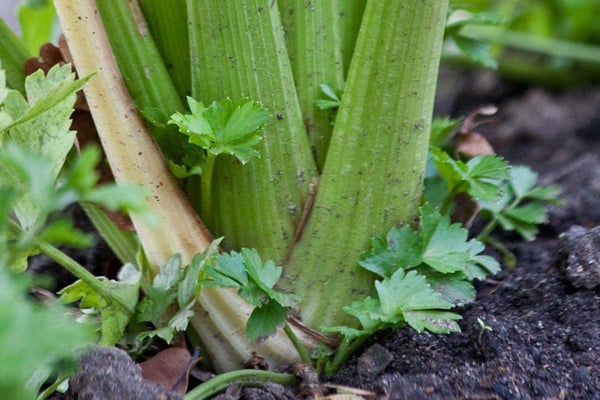
Getting Started
Although this classic salad vegetable can be a little tricky to grow, needing warmth and consistently damp conditions, it’s well worth the effort to produce your own crunchy, tangy, juicy celery, fresher than anything you can buy in the shops.
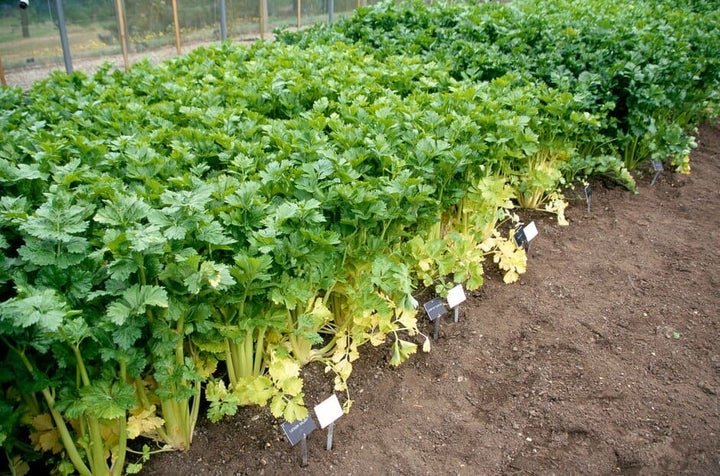
The wild celery plant (Apium graveolens), from which cultivated varieties have been bred, grows on boggy riversides and marshy ground. This gives a clue to the conditions this popular salad vegetable needs – moisture-retentive soil that never dries out. If you’re in an area with regular summer droughts or very free-draining soil, this may not be the crop for you.
Traditionally, celery was grown in trenches and soil was gradually piled up around the stems, in a similar way to potatoes. Excluding light in this way (known as blanching) reduces bitterness and makes the stems more tender. However, this trench method took a lot of time, space and effort, so is rarely used nowadays. Instead, newer ‘self-blanching’ and green varieties are planted closer together in a block, to reduce the amount of light reaching the stems. For the best quality results though, you should still blanch those on the outside of the block, but this is easily done by tying newspaper around them.
Celery is a classic salad vegetable, refreshing and crunchy. It can also be cooked in various ways, made into soup or added to stews. Celery is nutritious too – don’t be fooled by its high water content into thinking there’s nothing to it – it’s rich in nutrients, antioxidants and fibre, plus has barely any calories. And, of course, if you grow it yourself, it’ll be far fresher than shop-bought celery and packed with even more flavour and goodness.
Jobs to do now
Harvest trench celery
Month by Month
Sow
Plant Out
Harvest
Choosing What To Grow
Almost all the varieties of celery available today are self- or green types, producing stems that are usually pale to mid-green, rather than white. Traditional ‘trench’ varieties, which require blanching (excluding light) to make the stems less bitter and paler, are rarely available, as they’re more time-consuming and tricky to grow successfully.
Different celery varieties mainly offer variations in plant size, sowing/harvesting times, hardiness and disease resistance. There are also a few varieties with red or pink stems. For consistent crops of tasty, high-quality celery, it’s best to choose F1 hybrid varieties. Look too for varieties with an RHS Award of Garden Merit (AGM), which shows they performed well in trials – see our list of AGM fruit and veg (135kB pdf) and our Recommended Varieties below.
You can also see many crops, including celery, in the veg plots at the RHS gardens, so do visit to see how they’re grown, compare different varieties and pick up tips and inspiration.
What and where to buy
Celery seeds are available in most garden centres and from online gardening retailers. Almost all are the easier self- or green varieties. If you want traditional trench varieties, try smaller specialist suppliers of heritage seeds.
Young celery plants may also be available in spring and early summer from larger garden centres and online suppliers, although the choice of varieties will be limited.
Recommended Varieties

‘Victoria’ AGM
One of the best flavoured varieties. Vigorous, quick-growing plants up to 1m tall, and slow to bolt.
Preparing The Ground
If possible, prepare the growing site for your celery in the autumn before sowing. Choose a sunny spot with fertile, moisture-retentive soil. Avoid sites where the soil dries out rapidly. Remove any weeds and dig in lots of well-rotted manure or garden compost, to improve moisture retention. Alternatively, if you're practising no-dig, the soil ahead of sowing or planting directly into the mulch.
Although trench celery is rarely grown nowadays, if you want to grow a trench variety using the traditional method, dig a trench 40–50cm (16–20in) wide and 30cm (12in) deep. Then refill it to 10cm (4in) below the top with a mix of well-rotted manure or garden and soil. Leave the remaining excavated soil nearby, ready to mound up around the crop in summer to blanch it. Trench varieties can also be grown in a similar way to self- types, using newspaper to blanch them instead of soil.
Sowing
Celery seeds need warm temperatures to germinate and a long growing season, so it’s best to sow indoors to get them off to a strong, early start. They should then be outdoors after the last frost, into rich, damp soil. If you don’t have the space to grow indoors, you can buy in late spring or early summer.
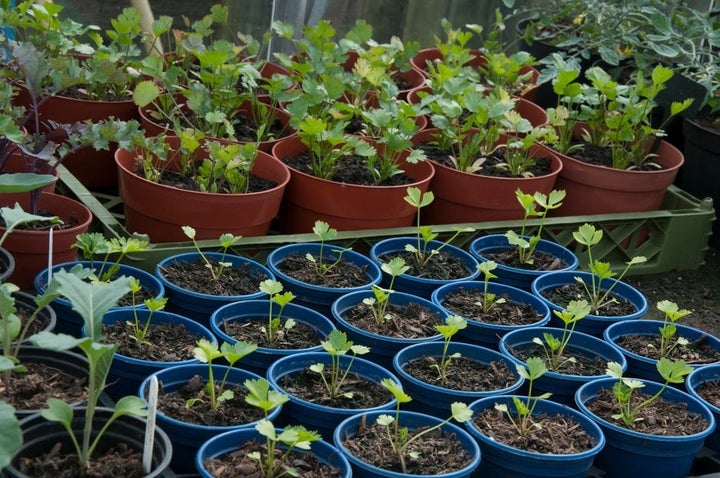
Sow celery seeds between mid-March and early April in seed trays, or small pots of moist peat-free . Sow thinly on the surface of the (covering with a very light dusting of sieved compost if you prefer) as celery seeds need light to germinate. Place in a or cover with a clear plastic bag and keep somewhere warm – at least 15°C (59°F) is needed to germinate. can be slow (up to three weeks), so patience may be required.
Once seedlings appear, give them plenty of light, water them regularly and keep them above 10°C (50°F) – lower temperatures can cause bolting (premature flowering) later. Move the seedlings into individual 7.5cm (3in) pots or modules when large enough to handle, which might not be until several true leaves appear. Seedlings already in modular trays should be thinned to one per module.
Young plants should be ready to plant outdoors about ten weeks after sowing, in late May or early June – see Planting below
Planting
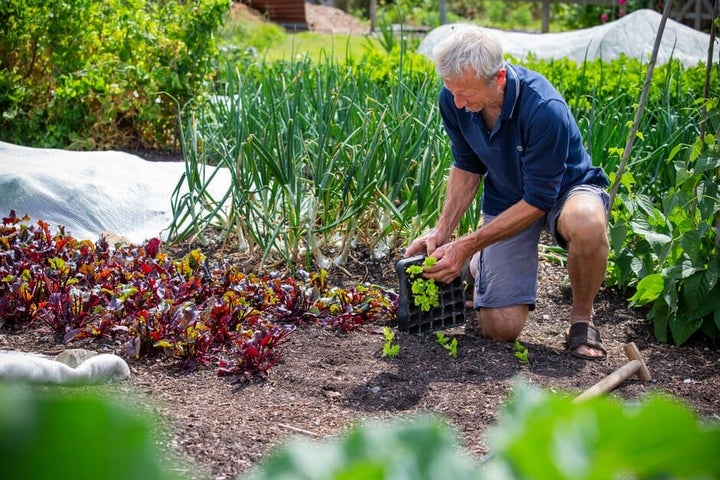
Young celery plants grown from seed indoors or bought as can be planted out once all risk of frost has passed in your area – usually by late May or early June. Take care to harden them off first, to acclimatise them to conditions outdoors. Young celery plants are sensitive to cold, so delay planting if necessary – temperatures mustn’t fall below 10°C (50°F) for longer than 12 hours until celery plants are well established.
Choose and prepare your planting site in advance – see Preparing the ground, above. Then plant the celery in a block rather than a row, spaced about 23cm (9in) apart in each direction. Plants will then shade each other, which helps to blanch the stems. If growing trench celery using the traditional method, plant in a single row, spacing plants 30–45cm (12–18in) apart.
After planting, cover the young celery plants with cloches or biodegradable fleece to improve growth and help to keep them warm, reducing the chances of bolting (premature flowering) later. Celery is liable to if chilled at this stage. Also protect them from slugs and snails, and water regularly, ideally using stored rainwater.
Planting in containers
Alternatively, you can plant celery in large containers, spacing plants 23cm (9in) apart. Use peat-free multi-purpose and position the container in a sunny, sheltered location. Just bear in mind that you will need to water them regularly and generously throughout the growing season, as the compost will dry out quickly.
Plant Care
The key to success with celery is plenty of moisture throughout the growing season. If the soil dries out, the stems won’t swell and will be very stringy.
Safety first
Take care when tending celery, as it can cause a skin rash – wear gloves and long sleeves to protect yourself.
Watering
Celery can become stringy and too strongly flavoured if it goes short of water so ensure plants have access to a steady supply of moisture throughout the growing season, but especially during warm weather when plants will be growing quickly. The soil should never be allowed to dry out.
If growing celery in containers, be prepared to water regularly in summer, as the potting will dry out rapidly. Use rainwater from a butt whenever possible, and on hot days water early in the morning or in the evening if you can, so the moisture doesn’t simply evaporate. For more water-wise tips, see our guides below.
Mulching
Lay a thick layer of over the soil around celery plants after planting, to help hold moisture in the ground, reduce the need for watering and deter weed . Use home-made garden compost or well-rotted manure, but leave a gap immediately around the base of the stems to avoid rot.
Feeding
Celery likes rich soil with plenty of nutrients. If you prepared your soil before planting, no additional feeding is usually necessary. However, if your soil is poor, or if you want to boost growth, you could apply a light dressing of a high nitrogen fertiliser in summer, once the plants are established.
When growing celery in pots, feed every fortnight with a balanced liquid fertiliser through the summer.
Weeding
Weed regularly, especially around young plants, to reduce competition for water. Celery tends to grow quite slowly, so can easily get swamped by vigorous weeds. It’s best to weed by hand close to celery plants, to avoid accidentally damaging the stems with a hoe blade.
Blanching stems
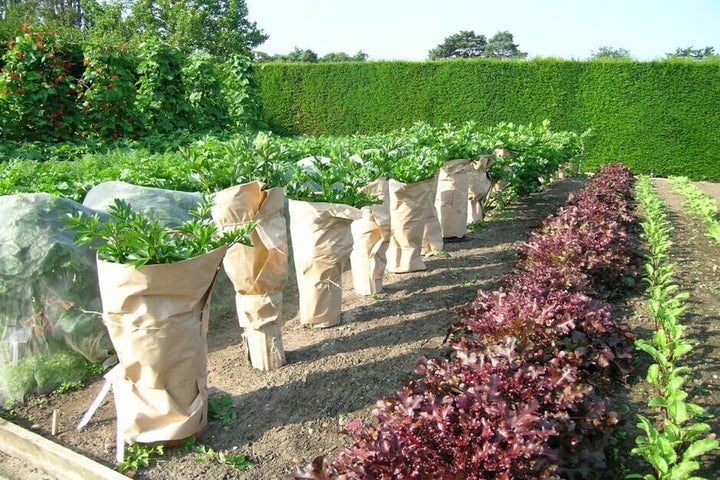
When self- or green celery plants are grown close together in a block, most don’t need blanching – just those on the outside of the block. You can, however, blanch all of them if you wish, as it should produce milder, sweeter stems. In mid- to late summer, tie a sleeve of newspaper or corrugated cardboard around the stems once they’re 30cm (1ft) tall, leaving the top third of the plant exposed.
If you’re growing trench celery using the traditional method, start mounding soil up around the stems (earthing up) in late summer to exclude light, gradually adding more as the stems grow taller. Alternatively, trench varieties can be blanched more easily with a newspaper or cardboard sleeve (see above).
Harvesting
Celery is ready to harvest once it reaches the desired size, from mid-summer to autumn:
- Self- and green varieties should be harvested as soon as they’re ready, before the leaves start to turn yellow, as the stems turn stringy with age. Most are not hardy, so cover with cloches or biodegradable fleece once night temperatures start to fall, and finish harvesting before the first frost
- Traditional trench celery is ready from late autumn to early winter. Protect from harsh frosts with
To harvest, dig up whole plants whenever needed. Use as soon as possible after harvesting, when crunchy, juicy and full of nutrients.
Problem Solving
Celery is composed of about 95 per cent water, so it’s not surprising that it needs regular watering to swell the stems, especially in warm weather, and can be dissapointing if moisture is lacking. Prepare the ground well before planting and afterwards to help hold moisture in the soil.
Celery can be prone to bolting (flowering prematurely) if young plants are exposed to cold, so ensure they stay above 10°C (50°F). Keep them indoors until late May or early June, harden them off carefully, then protect with cloches or plastic-free fleece for several weeks. Choose -resistant varieties too.
Slugs and snails love celery, so take steps to deter or control them. Celery can also be affected by celery leaf mining fly and celery leaf spot – remove any leaves that have dry patches or spots, and avoid growing celery in soil where celery or its close relative celeriac have been grown in the past few years.
For more on how to spot and tackle these issues, see Common problems below.
Common Problems

Bolting in vegetables
Bolting is the term applied to vegetable crops when they prematurely run to seed, usually making them unusable. A cold spell or changes in day length...

Celery leaf mining fly
The larvae of celery leaf mining fly feed within the leaves of celery, celeriac and related plants. Damaged areas dry up and give the foliage a scorch...

Slugs and snails
Slugs and snails are common garden animals, and they are well suited to the damp, mild climate of the UK. A few species feed on garden plants, but mos...



